XIV: PHARMACOLOGIC CONSIDERATIONS
IN HIV-INFECTED PREGNANT PATIENTS
Paul
Pham, PharmD, and Patricia Barditch-Crovo, MD
I. LIST OF TABLES
Table 14-1: Antiretrovirals
Table 14-2: Commonly Used Antimicrobials for the Treatment and Prevention of Opportunistic Infections in HIV-Infected Patients
Table 14-3: Safety of Commonly Used Antimicrobials
Table 14-4: Drug Interactions of Antimicrobials
Table 14-5: Clinically Pertinent Food-Drug Interactions
Table 14-6: Drugs of Special Consideration in Women
Table 14-7: Alternative/Complimentary Medication to Avoid in Pregnancy
II. INTRODUCTION
The decision to administer drugs to a pregnant woman is largely based on the therapeutic benefit to the mother and/or fetus vs. the perceived risk to the developing fetus. Clinicians are usually advised to avoid prescribing drugs for pregnant patients because human safety data in pregnancy are lacking for many medications. However in some clinical situations the benefits far outweigh the risks. These are important considerations when selecting agents to treat patients with human immunodeficiency virus (HIV), to prevent its transmission, and to prevent associated opportunistic infections.
There is limited information concerning the safety of many antiretrovirals in pregnancy. Mutagenicity and teratogenicity studies in animals are the basis for most safety in pregnancy data. Animals are administered doses 5 to 20 times higher than those given to humans; clinical applicability is not always evident.
It is now standard care to treat HIV-infected patients with an “antiretroviral cocktail,” making it increasingly difficult to assess the safety of a single anti-retroviral agent. More prospective clinical data are needed. Clinicians are encouraged to report all in utero exposures to The Antiretroviral Pregnancy Registry (1-800-258-4263), a collaborative effort between the National Institutes of Health, the Centers for Disease Control and Prevention, and pharmaceutical companies. Outcome data compiled from the Registry are used to monitor birth defects.
The Food and Drug Administration (FDA) has developed a classification system to help clinicians choose agents safe for use in pregnancy (Tables 14-1, 14-2, 14-3, and 14-6).
III. RISKS OF ANTIRETROVIRAL DRUGS IN PREGNANCY
Certain antiretroviral agents should be avoided during pregnancy, either because of effects inherent to the drug itself, or the potential for dangerous interactions. Administration of efavirenz to pregnant cynomolgus monkeys is associated with anencephaly, unilateral anophthalmia, microophthalmia and cleft palate in newborns (DuPont, 1998). Hydroxyurea produces mutagenesis and teratogenesis in many animal species; it should not be given during pregnancy (Shepard, 1992).
Antiretroviral therapy is often complicated by side effects in relatively healthy HIV-infected nonpregnant adults that could be exacerbated in pregnancy or put the fetus at risk. Protease inhibitors, for example, have been associated with the development of glucose intolerance and even diabetes mel-litus. Hyperglycemia in pregnancy leads to increased risk of macrosomia, fetal distress, preeclampsia, and stillbirth (Ndiaye, 1997). In patients taking indinavir, 10% develop indirect bilirubinemia (i.e., > 2.5%), and nephrolithiasis has been reported in 5–15% (Merck, 1998). Any of these adverse effects will complicate a pregnancy.
Because many patients turn to complimentary or alternative therapies, it is important to take a complete medication history, including over-the-counter drugs and nutritional supplements. St John’s wort lowers trough indinavir drug concentrations by 81% when administered concurrently (Piscitelli, 2000). Because St. John’s wort induces cytochrome P450 3A enzymes, it will likely decrease levels of other protease inhibitors and non-nucleoside reverse tran-scriptase inhibitors. Therefore, St. John’s wort should not be taken with anti-retroviral medications. Because safety data for herbal alternative therapies are scarce, these agents should be avoided during pregnancy. Table 14-6 summarizes data on alternative therapies to avoid during pregnancy.
IV. BENEFITS OF ANTIRETROVIRAL DRUGS IN PREGNANCY: DRUGS TO CONSIDER
One example in which the benefit far outweighs the risk of drug administration during pregnancy is evident in the use of zidovudine (AZT) in preventing perinatal HIV transmission (ACTG study 076) (Connor, 1995).. Administration of AZT to the pregnant HIV-infected mother after the first trimester, during labor, after labor, and to the newborn reduced the perinatal acquisition of HIV. In addition, uninfected infants exposed to AZT in this study and followed to a median age of 3.9 yr have not shown a significant difference in growth, neurologic development, or immune status when compared with unin-fected infants exposed to placebo (Hanson, 1999). The use of AZT during pregnancy and delivery has become the standard of care in the United States; however because of its high cost, its administration during pregnancy is not feasible in developing countries.
The HIVNET 012 trial compared the administration of one dose of nevi-rapine given orally to the mother during labor followed by one dose of nevirap-ine to the infant within 72 hr after birth with the administration of AZT during labor followed by AZT to the infant for 7 days. The 14–16-wk postdelivery data showed that although both regimens were well tolerated, 25.1% of infants in the AZT arm and 13.1% of infants in the nevirapine arm were infected with HIV (p=.0006)(Guay, 1999). Although long-term safety data are not currently available for nevirapine, this regimen may provide a simple and inexpensive regimen to prevent perinatal transmission of HIV in less developed countries. The current guidelines state that pregnancy per se should not preclude use of optimal therapeutic regimens. Therefore pregnant women should be treated according to standard guidelines for antiretroviral therapy in adults, with sustained reduction of viral load as the primary objective(CDC, 1998).
Although many physiologic changes occur during pregnancy, few trials have been conducted to evaluate their clinical significance on the pharmacokinetics of commonly used drugs. Physiologic changes that may affect drug pharmaco-kinetics include delayed gastric emptying, decreased intestinal motility, increased volume of distribution (an average increase of 8 L), increased renal blood flow (by 25–50%), and glomerular filtration rate (by 50%) (Davidson, 1974; Dunihoo, 1992; Parry, 1970). The serum half-life of nevirapine is reduced from 66 hr in nonpregnant women to 45 hr in pregnant women; this decrease is not likely to be clinically significant (Mirochnick, 1998). Pregnancy does not change the pharmacokinetics of AZT, 3TC, and ddI (Moodley, 1998; Schuman, 1990; Wang, 1999).
The absorption and pharmacokinetics of many of the anti-HIV drugs are affected by food. Table 14-5 lists pertinent food-drug interactions that are probably as valid for pregnant women as for a nongravid population.
Table 14-1, on the following pages, provides a quick reference on dosing recommendations, FDA Pregnancy Risk Classification, animal teratogenicity, and human experience in pregnancy for the most commonly prescribed drugs in the treatment of HIV infection.




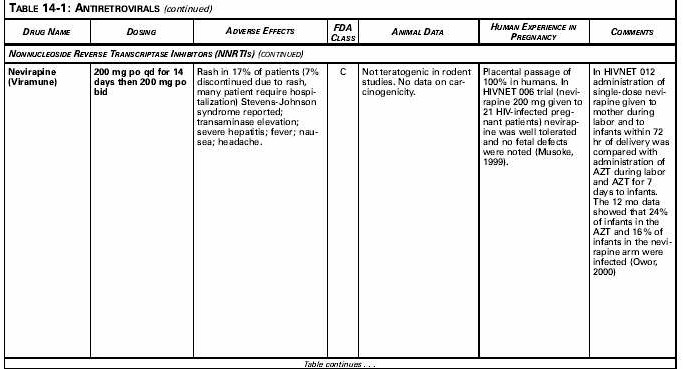



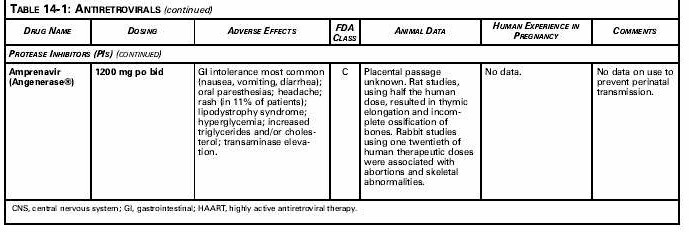








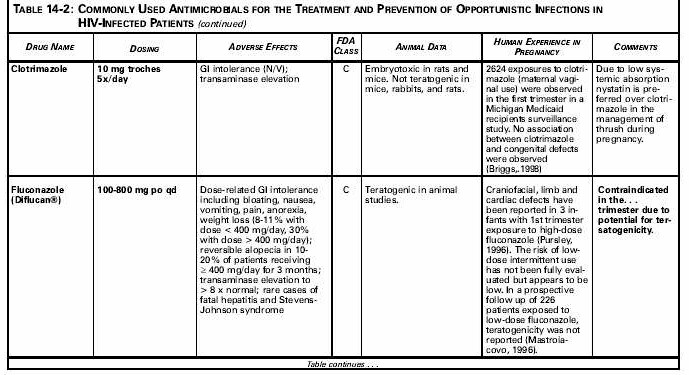


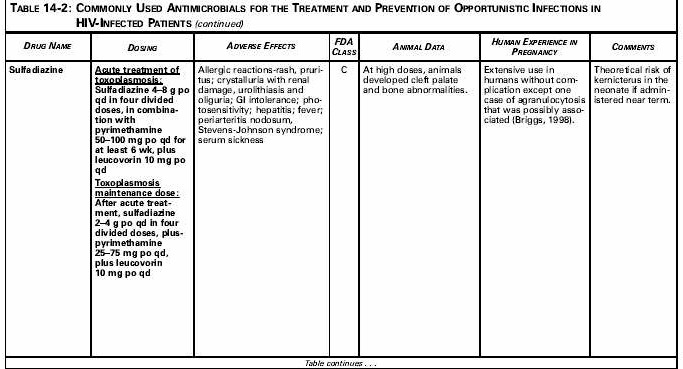
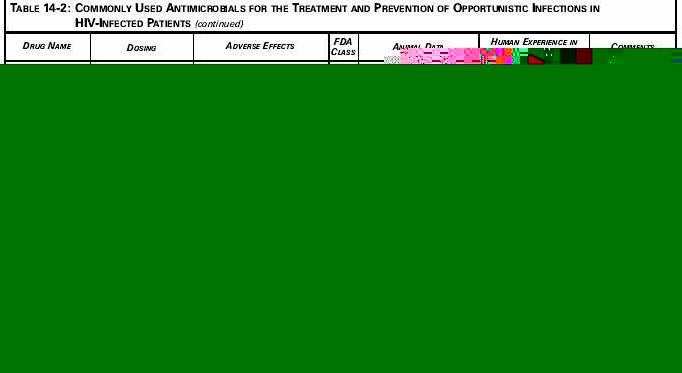
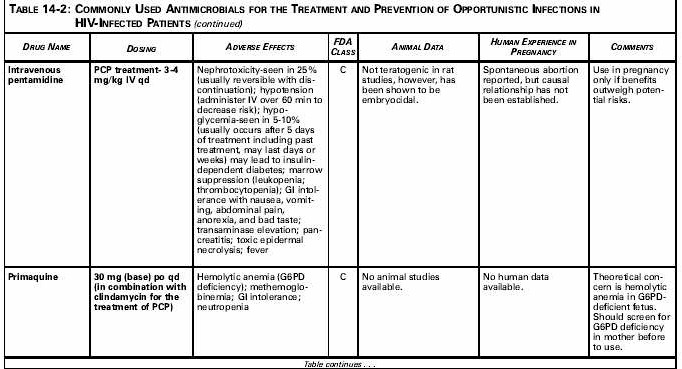





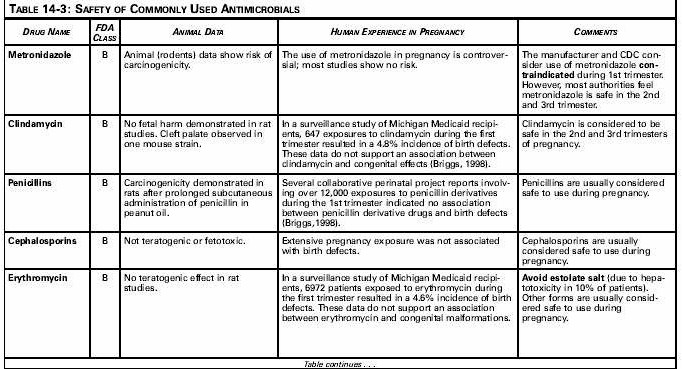




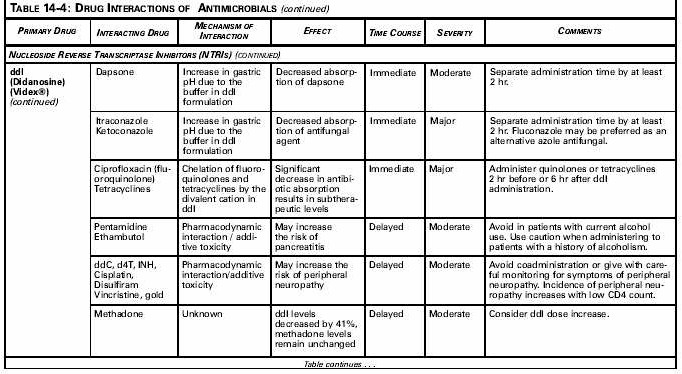

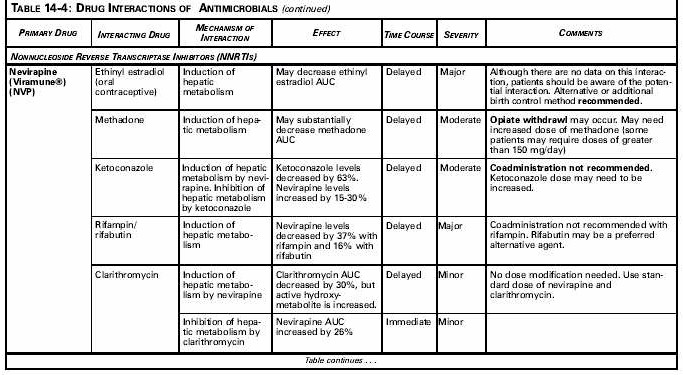





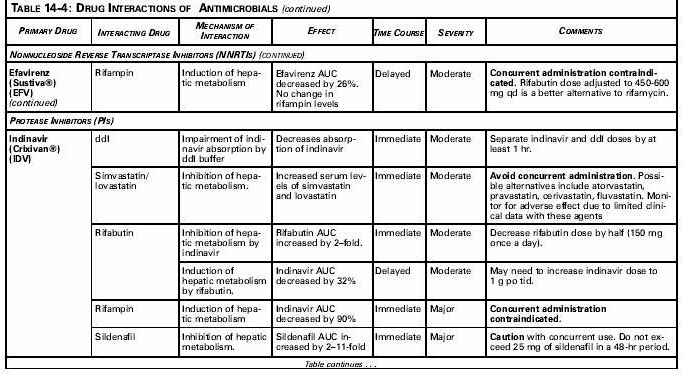
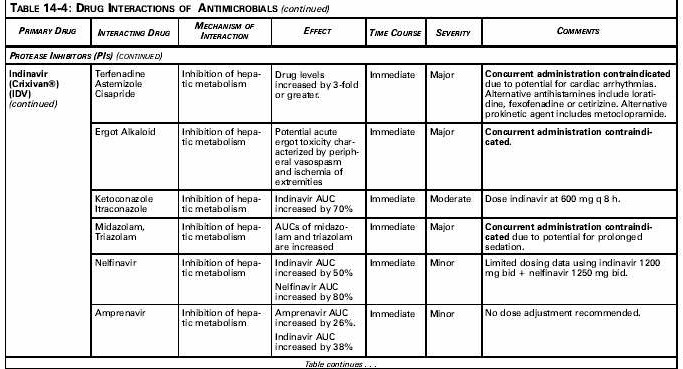







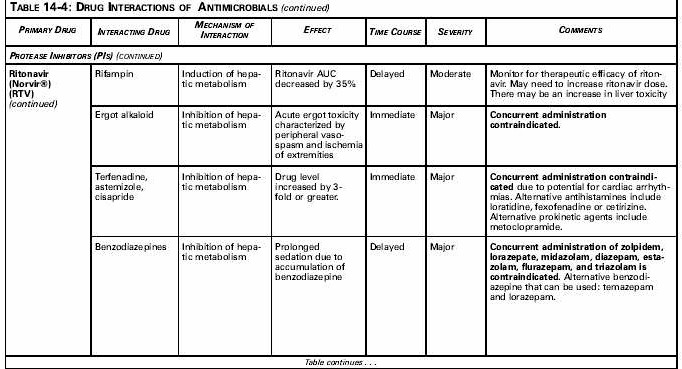

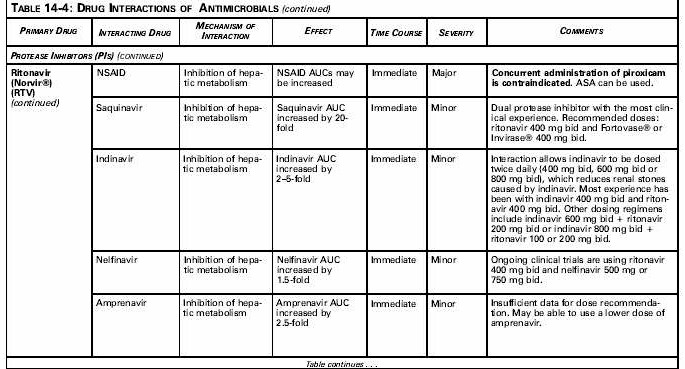

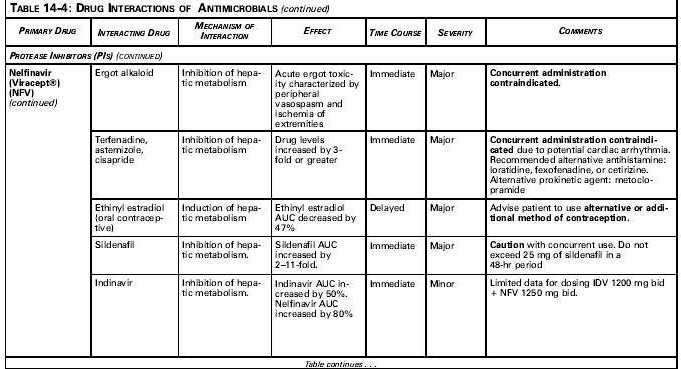

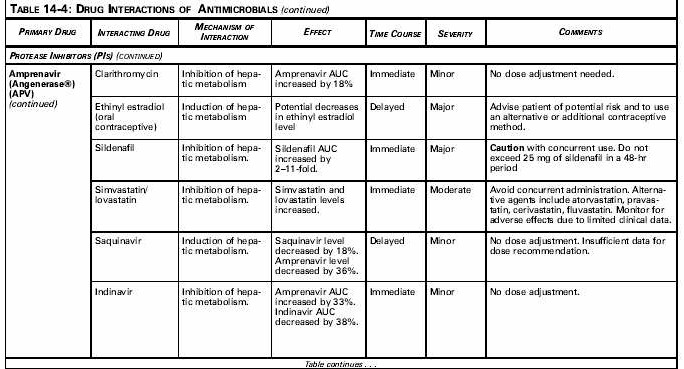

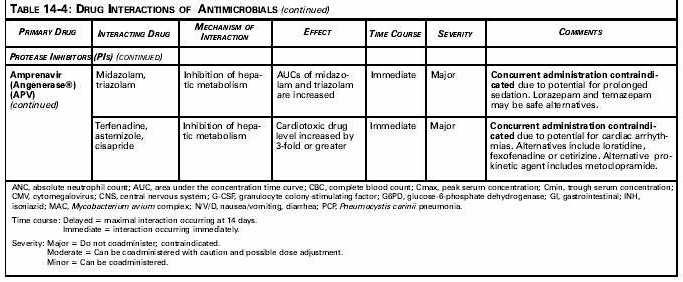






REFERENCES
Adair CD, Gunter M, Stovall TG, McElroy G, Veille JC, Ernest JM. Chlamydia in pregnancy: a randomized trial of azithromycin and erythromycin. Obstet Gynecol 91: 165–8, 1998.
American Thoracic Society. Medical Section of the American Lung Association. Treatment of tuberculosis and tuberculosis infection in adults and children. Am Rev Respir Dis 134: 355–63, 1986.
Bawdon RE. The ex vivo human placental transfer of the anti-HIV nucleoside inhibitor abacavir and the protease inhibitor amprenavir. Infect Dis Obstet Gynecol 6: 244–6, 1998.
Bobrowitz ID. Ethambutol in pregnancy. Chest 66: 20–4, 1974.
Briggs, Freeman, Yaffe, eds. Drugs in Pregnancy and Lactation: A Reference Guide to Fetal and Neonatal Risks. Baltimore: Williams & Wilkins, 1998 CDC. Adverse events associated with ephedrine-containing products--Texas, December 1993-September 1995. MMWR 45: 689–93, 1996.
CDC. Public Health Service Task Force recommendations for the use of antiretroviral drugs in pregnant women infected with HIV-1 for maternal health and for reducing perinatal HIV-1 transmission in the United States. MMWR 47(RR-2): 1–30, 1998.
Connor E, Mofenson L. Zidovudine for the reduction of perinatal human immunodefi-ciency virus transmission: Pediatric AIDS Clinical Trials Group Protocol 076. Results and treatment recommendations. Pediatr Infect Dis J 14: 536–41, 1995.
Davidson JM, Hytten FE. Glomerular filtration during and after pregnancy. J Obstet Gynaecol 81: 588–95, 1974.
Dunihoo DR. Maternal physiology. In: Dunihoo DR, ed. Fundamentals of Gynecology and Obstetrics. Philadelphia: J.B. Lippincott Co. 1992, 280–40.
DuPont. Sustiva (Efavirenz) Capsules product monograph. Wilmington, DE: DuPont Pharmaceutical, 1998.
Hanson C, Antonelli TA, Sperling RS, et al. Lack of tumors in infants with perinatal HIV exposure and fetal neonatal exposure to zidovudine. J Acquir Immune Defic Syndr Hum Retrovirol 20: 463–7, 1999.
Glaxo Wellcome. Acyclovir pregnancy registry, 1996.
Guay LA, Musoke P, Fleming T, et al. Intrapartum and neonatal single-dose nevirapine compared with zidovudine for prevention of mother-to-child transmission of HIV-1 in Kampala, Uganda: HIVNET 012 randomized trial. Lancet 354: 795–802, 1999.
Gray G. The PETRA study: early and late efficacy of three short ZDV/3TC combination regimens to prevent mother-to-child transmission of HIV-1. XIII International AIDS Conference, Durban, South Africa (Abst LbOr5), July 9–14, 2000. Kaplan JE, Masur H, Holmes KK, Wilfert CM, Sperling R, Baker SA, et al.
USPHA/IDSA guidelines for the prevention of opportunistic infections in persons infected with human immunodeficiency virus: an overview. Clin Infect Dis 21 (Suppl 1): S12–31, 1995.
Kim HL, Streltzer J, Goebert D. St. John's wort for depression: a meta-analysis of well-defined clinical trials. J Nerv Ment Dis 187: 532–38, 1999.
Livingston E, Patil S, Unadkat J, McKinney R, Abreu E, Bardequez A, et al. Placental transfer of didanosine (ddI) and initial evaluation of didanosine toxicity in HIV-1 infected pregnant women and their offspring. In: Program and Abstracts of the 5th Conference on Retroviruses and Opportunistic Infections. Feb 1–5, 1998, Chicago. Abst 226.
Luzzi GA, Peto TE. Adverse effects of antimalarials. An update. Drug Saf 8: 295–311, Review, 1993.
Mastroiacovo P, Mazzone T, Botto LD, Serafini MA, Finardi A, Caramelli L, et al. Prospective assessment of pregnancy outcomes after first-trimester exposure to fluconazole. Am J Obstet Gynecol 175: 1645–50, 1996.
Mastroiacovo P, Mazzone T, Addis A, Elephant E, Carlier P, Vial T, et al. High vitamin A intake in early pregnancy and major malformations: a multicenter prospective controlled study. Teratology 59: 7–11, 1999.
Matsui D. Prevention, diagnosis, and treatment of fetal toxoplasmosis. Clin Perinatol 21: 675–89, Review, 1994.
Merck. Crian (Indinavir) Capsules product monograph. West Point, PA: Merck & Co, 1998.
Mirochnick M, Fenton T, Gagnier P, et al. Pharmacokinetics of nevirapine in human immunodeficiency virus type 1- infected pregnant women and their neonates. Pediatric AIDS Clinical Trials Group Protocol 250 Team. J Infect Dis 178: 368–74, 1998.
Moodley J, Moodley D, Pillay K, Coovadia H, Saba J, van Leeuwen R, et al. Pharmacoki-netics and antiretroviral activity of lamivudine alone or when coadministered with zidovudine in human immunodeficiency virus type1-infected pregnant women and their offspring. J Infect Dis 1778: 1327–33, 1998.
Musoke P, Guay LA, Bagenda D, Mirochnick M, Nakabiito C, Fleming T, et al. A phase I/II study of the safety and pharmacokinetics of nevirapine in HIV-1-infected pregnant Ugandan women and their neonates (HIVNET 006). AIDS 13: 479–86, 1999.
Nanda D, Tannebaum I, Landesman S, Mendez H, Moroso G, Minkoff H. Pentamidine prophylaxis in pregnancy. Am J Obstet Gynecol 166: 387, 1992.
Ndiaye O, Gbaguidi A, Ba M, et al. Newborn infant with macrosomia: etiologic factors and perinatal complications. Dakar Med 42: 159–61, 1997.
Owor M, Desyve M, Duefield C, et al. The one year safety and efficicacy data of the HIVNET 012 trial. XIII International AIDS Conference, Durban, South African (Abst LbOr1), July 9–14, 2000.
Parry E, Shields R, Turnbull A. Transit time in the small intestine in pregnancy. J Obstet Gynaecol Br Commonw 77: 900–01, 1970.
Piscitelli SC, Burstein AH, Chaitt D, Alfaro RM, Falloon J. Indinavir concentrations and St. John’s wort. Lancet 355: 547–48, 2000.
Pursley TJ, Blomquist IK, Abraham J, Andersen HF, Bartley JA. Fluconazole-induced congenital anomalies in three infants. Clin Infect Dis 22: 336–40, 1996.
Rosa F. Azole fungicide pregnancy risks. Presented at the Ninth International Conference of the Organization of Teratology Information Services, Salt Lake City, Utah, May 2–4, 1996.
Saba J. Interim analysis of early efficacy of three short ZDV/3TC combination regimens to prevent mother-to-child transmission of HIV-1: the PETRA trial. Sixth Annual Conference on Retroviruses and Opportunistic Infections, Jan 31–Feb 4, 212: Abst S7, 1999. Pharmacologic Considerations of ARV Therapy in HIV-Infected Pregnant Patients
Schaefer C, Amoura-Elefant E, Vial T, Ornoy A, Garbis H, Robert E, et al. Pregnancy outcome after prenatal quinolone exposure. Evaluation of a case registry of the European Network of Teratology Information Services (ENTIS). Eur J Obstet Gynecol Reprod Biol 69: 83–9, 1996 .
Schick B, Hom M, Librizzi R, Donnenfeld A. Pregnancy outcome following exposure to clarithromycin. Reprod Toxicol 10: 162, 1996.
Schuman P, Kauffman R, Crane LR, et al. Pharmacokinetics of zidovudine during pregnancy. Int Conf AIDS, June 20–3; 6: 94 (Abst F.B.17), 1990.
Shepard TH. Catalog of Teratogenic Agents, 7th ed. Baltimore: John Hopkins University Press, pp. 206–7, 1992.
Silverman NS, Watts DH, Hitti J, Money DM, Livingston E, Axelrod J, et al. Initial mul-ticenter experience with double nucleoside therapy for human immunodeficiency virus infection during pregnancy. Infect Dis Obstet Gynecol 6: 237–43, 1998.
Snider DE Jr, Layde PM, Johnson MW, Lyle MA. Treatment of tuberculosis during pregnancy. Am Rev Respir Dis 122: 65–79, Review, 1980.
Svenningsen NW. Follow-up studies on preterm infants after maternal beta-receptor agonist treatment. Acta Obstet Gynecol Scand Suppl 108: 67–70 1982.
van der Horst CM, Saag MS, Cloud GA, Hamill RJ, Graybill JR, Sobel JD, et al. Treatment of cryptococcal meningitis associated with the acquired immunodeficiency syndrome. National Institute of Allergy and Infectious Diseases Mycoses Study Group and AIDS Clinical Trials Group. N Engl J Med 337: 15–21, 1997.
Wang Y, Livingston E, Patil S, et al. Pharmacokinetics of didanosine in antepartum and postpartum human immunodeficiency virus-infected pregnant women and their neonates: an AIDS clinical trial group study. J Infect Dis 180: 1536–41, 1999.
West KP, Jr, Katz J, Khatry SK, LeClerq SC, Pradhan EK, Shrestha SR, et al. Double blind, cluster randomised trial of low dose supplementation with vitamin A or carotene on mortality related to pregnancy in Nepal. BMJ 318: 570–75, 1999.
Wong S-Y, Remington JS. Toxoplasmosis in pregnancy. Clin Infect Dis 18: 853–62, 1994.